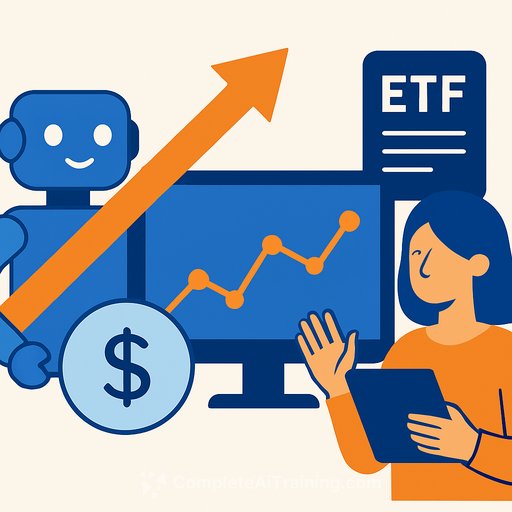AI, Product Innovation, and Next-Gen Investors: What the MMI-Broadridge 2025 Survey Means for Product Leaders
Asset and wealth managers are moving from talk to execution. The latest Money Management Institute and Broadridge survey shows AI rolling into daily workflows, product demand leaning hard into active ETFs and alternatives, and a widening gap between what younger investors expect and what firms deliver.
If you lead product or strategy, this is a clear brief: connect AI to measurable outcomes, modernize the product mix, and ship a client experience that earns attention across generations.
AI has moved from testing to production
95% of firms see AI as a net positive, and 96% expect a lift in per-employee productivity. The most immediate wins: communications and messaging (30%), research (20%), marketing/sales/content (15%), and data synthesis (14%). AI is now a high strategic priority for 61% of firms, up from 38% last year.
- Near-term build list: stand up an AI copilot for client and advisor communications, auto-summarize notes, and personalize follow-ups. Tie it to response rates and time saved.
- Automate research intake and synthesis with model prompts and compliance guardrails. Publish a weekly insight pack to sales and PMs.
- Unify CRM, portfolio, and content data so AI can find patterns you can act on. Establish clear roles for human review.
- Set governance now: data access policies, disclosure language, and QA checks. Small team, tight scope, fast iterations.
Product mix is shifting-build for flexibility and scale
Respondents expect the strongest asset growth from active ETFs (72%), private markets/alternatives (60%), and SMAs (51%). Asset managers are more bullish on active ETFs than wealth managers (78% vs 48%). And 57% of wealth managers say alternatives are still early relative to target allocations.
Fee pressure is real: 57% of wealth managers expect the move from mutual funds to ETFs to dent revenue. To offset this, firms plan to expand model portfolios, monetize data, and add services like overlay management and client reporting. 81% already support-or will support-alternatives within models.
- Roadmap implications: accelerate active ETF launches and mutual-to-ETF conversions. Upgrade PM tooling for intraday flows and tax handling.
- Build an "alts access layer": onboarding, education, liquidity solutions, and model integration. Make allocations simple to implement and review.
- Scale a model portfolio factory: overlays (tax, factor, risk), direct indexing, and intent-based templates for specific client goals.
- Use data responsibly for monetization: segment insights, product gaps, and adoption signals that help distribution and advisors.
If you need a quick primer you can share with stakeholders, see the SEC's overview of ETFs: Exchange-Traded Funds.
Distribution and client experience need AI-native workflows
AI is already creating lift in messaging, content, and sales enablement. The playbook: personalize communications at scale, reduce prep time for client meetings, and tighten feedback loops between research, product, and distribution.
- Advisor desktop: recommended next best action, pre-meeting briefs, and one-click content that fits compliance rules.
- Client reporting: explain performance, fees, and allocation changes in clear language-no jargon, less time.
- Marketing: auto-generate content variants and test them. Keep a human in the loop for tone and accuracy.
Next-gen investors and talent: clear intent, slow action
87% agree younger investors need different products or service models, yet only 30% are reorienting growth to this segment. Top hurdles: meeting digital expectations (42%), engaging through traditional channels (41%), and building long-term loyalty (35%).
Hiring will pick up: 48% plan to increase headcount in the next two years. Wealth managers lean into product specialists and tech support; asset managers spread investment across more roles.
- Experience upgrades: mobile-first onboarding, transparent pricing, progress tracking, and clear educational moments inside the product.
- Content strategy: short, actionable explainers on ETFs, alts, taxes, and planning-delivered in-channel, measured weekly.
- Org: appoint an AI product owner, add data engineers to your product triad, and train advisors on AI-assisted workflows.
KPIs to track into 2026
- Per-employee productivity (hours saved, cases handled) from AI features
- ETF net flows and mutual-to-ETF conversion velocity
- % of households in model portfolios and overlays
- Alt allocation penetration vs. targets and time-to-funding
- Digital NPS for clients under 40 and advisor satisfaction with tools
- Average time from product concept to first assets in
Start within 30 days
- Prioritize two AI use cases tied to revenue protection or growth-e.g., client reporting and sales communications.
- Spin up a cross-functional pod (product, compliance, data, distribution). Define guardrails and acceptance criteria.
- Select vendors and models, ship a pilot, and review results weekly. Expand only after you see signal.
- Draft the 12-month model portfolio roadmap: overlays, alts integration, and conversion paths from mutual funds.
For teams building skills and evaluating tooling for finance workflows, explore curated options here: AI tools for finance.
Methodology
The survey captured responses from 142 MMI members between July 16 and September 3, 2025, conducted with Broadridge and independent firm 8 Acre Perspective.
Your membership also unlocks:









